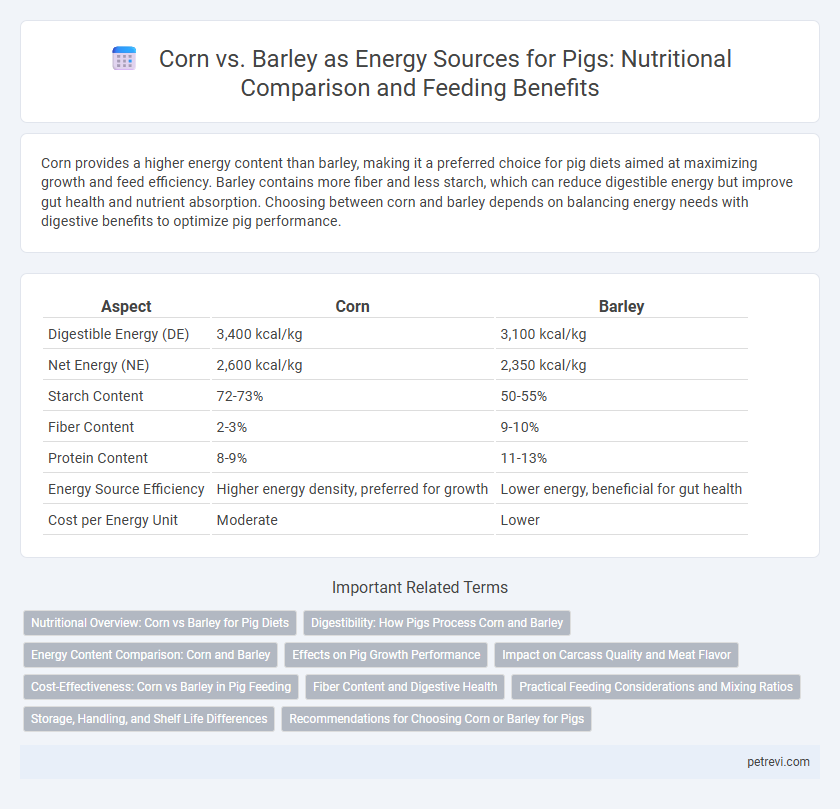Corn provides a higher energy content than barley, making it a preferred choice for pig diets aimed at maximizing growth and feed efficiency. Barley contains more fiber and less starch, which can reduce digestible energy but improve gut health and nutrient absorption. Choosing between corn and barley depends on balancing energy needs with digestive benefits to optimize pig performance.
Table of Comparison
| Aspect | Corn | Barley |
|---|---|---|
| Digestible Energy (DE) | 3,400 kcal/kg | 3,100 kcal/kg |
| Net Energy (NE) | 2,600 kcal/kg | 2,350 kcal/kg |
| Starch Content | 72-73% | 50-55% |
| Fiber Content | 2-3% | 9-10% |
| Protein Content | 8-9% | 11-13% |
| Energy Source Efficiency | Higher energy density, preferred for growth | Lower energy, beneficial for gut health |
| Cost per Energy Unit | Moderate | Lower |
Nutritional Overview: Corn vs Barley for Pig Diets
Corn provides a higher energy content primarily from starch, making it a preferred carbohydrate source for pig diets, whereas barley contains more fiber and beta-glucans, which can impact digestibility. The metabolizable energy (ME) value of corn typically ranges around 3,400 kcal/kg, compared to barley's 2,800-3,000 kcal/kg, reflecting corn's superior energy density. Barley's higher protein (10-13%) and fiber content may benefit gut health but require enzyme supplementation to optimize nutrient absorption in pigs.
Digestibility: How Pigs Process Corn and Barley
Pigs digest corn more efficiently than barley due to its higher starch content and lower fiber levels, resulting in greater energy availability. Barley contains more non-starch polysaccharides, which reduce digestibility and slow energy release. Enzymatic supplementation can improve barley's digestibility, but corn remains superior for maximizing pig energy utilization.
Energy Content Comparison: Corn and Barley
Corn provides a higher energy content than barley in pig diets, primarily due to its greater starch concentration, which enhances digestible energy and metabolizable energy values. Barley contains more fiber, reducing its net energy availability compared to corn, making corn more efficient for growth performance. Optimizing pig feed with corn as the primary energy source can improve feed conversion ratios and overall weight gain.
Effects on Pig Growth Performance
Corn provides higher energy density than barley, promoting improved average daily gain (ADG) and feed conversion ratio (FCR) in pigs. Barley contains more fiber, which can reduce nutrient digestibility and consequently slow growth rates compared to corn-based diets. Studies show pigs fed corn-based diets exhibit greater weight gain and better lean tissue deposition due to enhanced metabolizable energy availability.
Impact on Carcass Quality and Meat Flavor
Corn provides higher energy density than barley, resulting in improved weight gain and leaner carcass traits in pigs. Barley, rich in fiber and certain volatile compounds, may enhance meat flavor but can lead to slightly lower carcass yield due to reduced digestible energy. Optimal feed formulation balances energy supply and palatability to maximize carcass quality and desirable meat flavor profiles in swine production.
Cost-Effectiveness: Corn vs Barley in Pig Feeding
Corn generally provides a higher energy content per unit cost compared to barley, making it a more cost-effective option for pig feeding. Barley contains more fiber and lower starch levels, which can reduce digestible energy and thus require higher inclusion rates or supplemental enzymes to match corn's energy efficiency. Despite these differences, local market prices and availability can influence the economic advantage, with some producers favoring barley when corn prices rise or supply is limited.
Fiber Content and Digestive Health
Corn provides a higher energy content with lower fiber levels compared to barley, making it a dense energy source for pigs. Barley contains significantly more dietary fiber, which enhances gut motility and supports beneficial microbial populations, promoting improved digestive health. Incorporating barley in pig diets can alleviate digestive issues linked to low fiber intake, while corn optimizes energy density for growth performance.
Practical Feeding Considerations and Mixing Ratios
Corn provides higher energy density and digestible carbohydrates compared to barley, making it preferred for growth performance in pigs. Barley contains more fiber, which can reduce energy availability but supports gut health and better pellet quality in feeds. Practical mixing ratios often include 70-80% corn and 20-30% barley, balancing energy supply with fiber benefits for optimal pig nutrition and feed efficiency.
Storage, Handling, and Shelf Life Differences
Corn provides a higher energy density than barley, making it more efficient for pig feed storage by requiring less volume. Handling corn is generally easier due to its uniform kernel size and hardness, which reduces feed processing issues and equipment wear compared to the more variable barley. Corn also offers a longer shelf life with lower susceptibility to spoilage and mold growth, enhancing storage stability for pig producers.
Recommendations for Choosing Corn or Barley for Pigs
Choosing corn as an energy source for pigs is recommended when a higher energy density and better digestibility are required, especially for growing and finishing pigs. Barley offers advantages in fiber content and can improve gut health, making it suitable for sows and pigs in cooler climates where energy demands are lower. Evaluate factors such as nutrient availability, cost-effectiveness, and pig production stage to optimize feed formulation and maximize growth performance.
Corn vs Barley for Pig energy source Infographic

 petrevi.com
petrevi.com